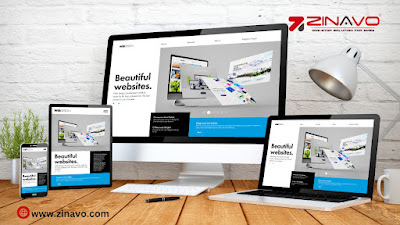How Modern Web Design Can Drive Business Conversions
Introduction
A website is often the first point of contact between a potential customer and your company in today's digital-first world. It's more than just an online brochure; it's a critical sales tool, a lead generation machine, and a reflection of your brand's professionalism. The difference between a website that simply exists and one that actively grows your business often comes down to one key factor: modern web design.
A modern, well-designed website isn’t just about aesthetics. It’s a strategic asset built to guide visitors seamlessly toward a desired action. This is whether it's making a purchase, filling out a form, or calling your business. This process is known as conversion, and a thoughtfully designed website is the engine that drives it. Your online presence can be transformed into a powerful business tool by focusing on user experience (UX), responsive design, and strategic content placement.
The Power of a Strong First Impression
A cluttered, slow-loading, or outdated website undermines trust and professionalism. Clean, visually appealing, and fast-loading sites create a positive first impression, indicating to visitors that your business is credible and reliable.
This first impression is deeply tied to the concept of user experience (UX) design, which is about creating a positive and intuitive journey for the user. Modern web design prioritizes effortless experiences by using clean layouts, logical navigation, and clear calls-to-action (CTAs). Providing visitors with easy access to what they are seeking and clear instructions on what to do next increases the likelihood they will engage with your content and, ultimately, convert.
Optimizing for Mobile: The Non-Negotiable Factor
In the past decade, mobile internet usage has exploded, with the majority of web traffic now coming from smartphones and tablets. If your website is not designed to be easily accessible and functional on a mobile device, you are effectively turning away a significant portion of your potential audience. This is where responsive design becomes a critical component of modern web design.
Responsive design ensures your website adapts and displays correctly across all screen sizes, from a large desktop monitor to a small smartphone. A truly mobile-friendly site isn't just a shrunken-down version of its desktop counterpart; it's a carefully crafted experience that prioritizes readability, tap-friendly buttons, and simplified navigation for on-the-go users. Failing t rovide a seamless mobile experience leads to high bounce rates, as users become frustrated and leave. By investing in responsive design, you ensure that every visitor, regardless of their device, has an optimal experience, significantly increasing the likelihood of a conversion.
The Role of Content and Calls-to-Action (CTAs).
A stunning website with no clear direction is like a beautiful map with no destination. Modern web design strategically integrates content to guide visitors to the desired action. This involves a thoughtful hierarchy of information, compelling headlines, and, most importantly, powerful calls-to-action (CTAs).
Ensure that your call-to-actions are not difficult to miss. They should be visually distinct, use action-oriented language, and be placed at key points in the user journey. For example, a "Schedule a Free Consultation" button or a "Download Our E-Book" button should stand out from the rest of the page. The design principles of color psychology, contrast, and negative space play a role here. This ensures that the CTA is the hero of the section and the user feels compelled to click.
Beyond the CTA, the content itself must be scannable and digestible. Modern web design uses concise paragraphs, bullet points, and high-quality visuals to break up text and make information easy to absorb. When visitors understand the value you offer, they are more likely to take the next step.
Building Trust and Credibility
Trust is the foundation of every transaction. Modern web design builds trust by looking professional, transparent, and featuring credibility-boosting elements. This includes client testimonials, case studies, high-resolution images of your team or products, and industry-specific certifications or badges. These elements should be seamlessly integrated into the design, providing social proof that your business is trustworthy and effective.
Modern design also ensures high website security levels. Using a secure protocol (HTTPS) and displaying trust signals like security badges can reassure visitors that their information is safe. This is particularly crucial for e-commerce sites or any website that handles sensitive user data. A secure website is one where users are comfortable converting.
Strategic use of visuals and motion
Modern websites aren't static. Strategic visuals and motion, such as subtle animations, short videos, and interactive elements, can significantly improve user engagement. These features can be used to highlight key information, tell your brand's story, and create a more dynamic and memorable experience.
For example, scrolling animation that reveals a product's features as the user navigates down the page can be more engaging than a simple static image. Similarly, a hero section with a brief, high-quality video can immediately communicate your brand's mission and value proposition. These visual elements, when used correctly, don't just look awesome ; they serve a purpose, keeping the user engaged long enough to find what they're looking for and convert.
Conclusion
Modern web design is an investment in your business's future. It’s a strategic choice to prioritize your customers' experiences, build trust, and actively guide them towards your business goals. It is important to focus on creating a responsive, user-friendly, and visually compelling design in order to increase your conversion rates, attract more leads, and grow your business.
For More Information: Call us: +91 80-35694395 Whatsapp us : +91-7760245945 Mail: info@zinavo.com Website: https://www.zinavo.com




Comments
Post a Comment